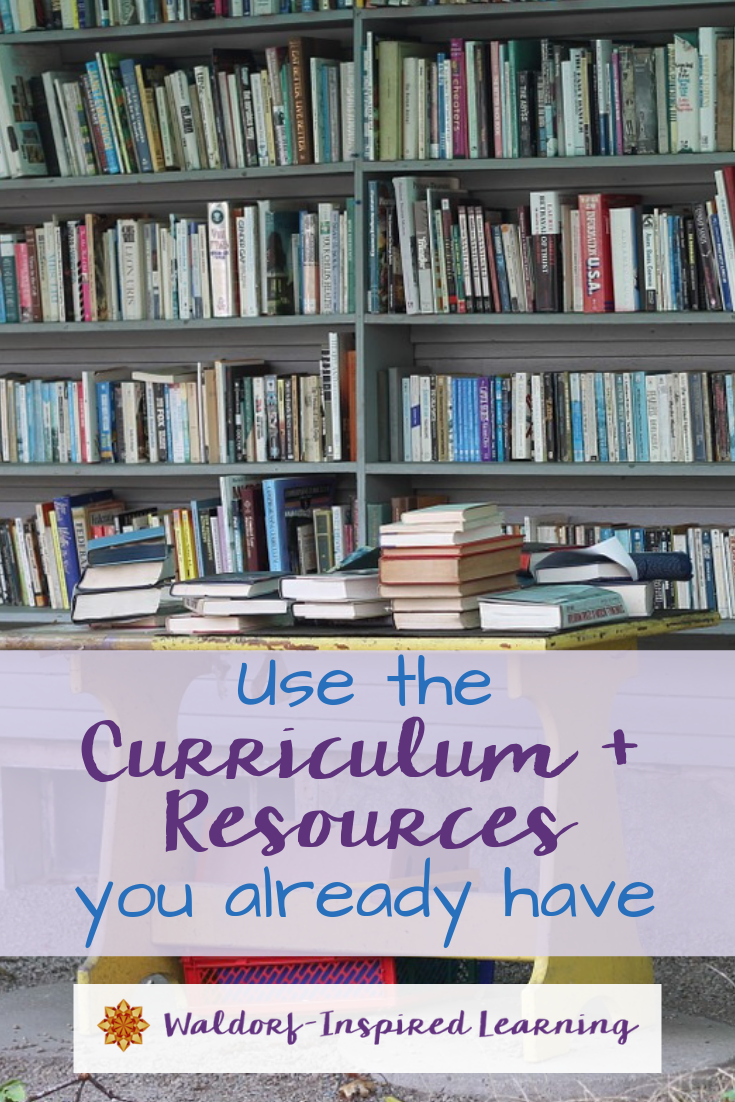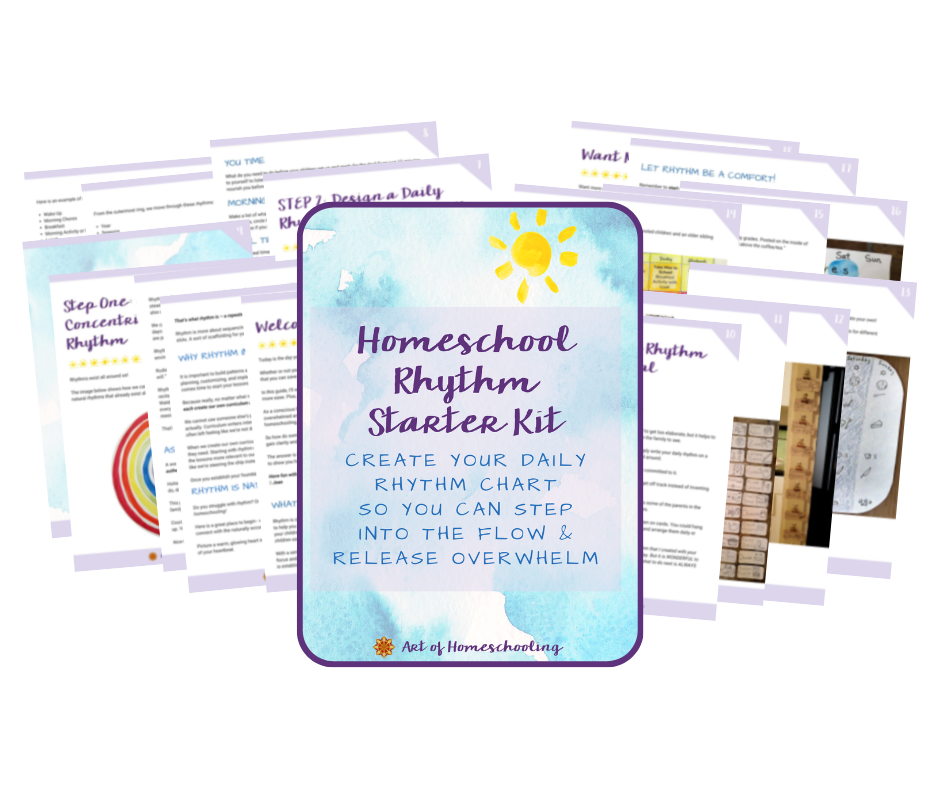Finding curriculum and resources for Waldorf homeschooling is challenging. I would venture to guess that we all have full bookshelves. There’s nothing wrong with this at all! But I would also venture to guess that all of those resources and curricula might not give you exactly what you’re looking for.
Oftentimes, we continue searching even after the bookshelves are full. Because we think that finding curriculum and resources for Waldorf homeschooling is the end of the preparation process.
I want to tell you that what we are searching for is not the perfect curriculum.

For starters, the perfect homeschooling curriculum doesn’t exist. Secondly, what we’re really searching for is confidence and ease. We don’t want to struggle, and somehow we’ve allowed ourselves to believe that the right curriculum will alleviate those feelings of struggle and practically do the teaching for us!
I’m here to tell you (after 20+ years of homeschooling) that we really just need to dive in and get on with it. And the most direct way to do that is this:
Use the curriculum and resources you already have!
We don’t want to get stuck in “search and do.” That state of constantly searching for someone to just tell us what to do, and then we’ll do it.
Instead, we want to switch “search and do” to “understand and create.”
The Waldorf method of education and homeschooling goes way beyond the curriculum. And the truth is, the most important part of the curriculum isn’t the plan on paper but what gets carried out and what our children learn from those experiences.
So how do we move from “search and do” to “understand and create”?
By understanding the foundation of Waldorf principles so that we can create a main lesson block around any beautiful book or subject.
Finding Curriculum and Resources for Waldorf Homeschooling
Here are the 3 key principles that form the foundation of Waldorf education. We want to embrace these, no matter what curriculum or resources we might use. With each principle, I include a link to a post in the Steiner Cafe that is relevant and further explains that principle.
- The stages of child development determine the how and why of the curriculum. Read: The Three Stages of the Waldorf Curriculum
- The lively arts are woven into all lessons. Read: The Arts Engage the Will & The Seven Lively Arts
- Rhythm guides our seasons, weeks, day, and lessons. Read: Rhythm is (Always) the Answer
Once we understand these principles, we can create our own main lesson blocks around just about any book or subject!
Our job as homeschooling parents is to create the space for learning and offer learning opportunities to our children. And this process needs to work for both them and us in order to be sustainable!
There are lots of components to Waldorf education. And it’s important to know that you can create your own main lessons that suit your particular child(ren) and family. That’s what Steiner had in mind when he said…
Where is the book in which the teacher can read about what teaching is? The children themselves are this book. We should not learn to teach out of any book other than the one lying open before us and consisting of the children themselves. In order to read in this book, however, we need the widest possible interest in each individual child, and nothing must divert us from this.
-Rudolf Steiner, Human Values in Education
Does this mean we should avoid buying curriculum all together? No, not necessarily. But it might mean we need to shift our attitudes a bit! From “search and do” to “understand and create.”
Every education is self-education, and as teachers we can only provide the environment for children’s self-education. We have to provide the most favorable conditions where, through our agency, children can educate themselves according to their destinies.
-Rudolf Steiner, “Gratitude, Love, and Duty”
I hope this empowers you to use what you already have! Or go to the library. Or buy a few key resources for specific blocks you plan on doing. Because finding curriculum and resources for Waldorf homeschooling is only the beginning of the process.
No need for endless searching.
Just a switch from thinking “search and do” to “understand and create.”
If you are just starting out with homeschooling or Waldorf, my Homeschool Simplicity 101 is a great place to begin your journey. It’s a collection of resources and trainings full of proven strategies and encouragement.
If you want help working through my 6 steps to planning your block or year, come join an amazing group of homeschooling parents in Plan It Out: an Online Course + Group Coaching Program for Waldorf Homeschoolers.



Such valuable advice! !!!!
Yes, thanks Barbara!
Love this post, Jean! It speaks to me as I (& you!) know how I struggled with this particular issue more than once. Thanks for the reminder to curtail endless searching…applicable to more than just our homeschooling endeavors.
Yes, it’s an ongoing struggle for all of us! And great point that it applies to more than just our homeschooling endeavors!
Please talk about this more! It is something I struggle with and feel you have only touched on the tip of a great “paradigm”berg : )
Yes, I think it’s a struggle for many homeschoolers, April. You are not alone! I will definitely be talking about this more. It’s so important to understand how to create main lesson blocks so that you can craft lessons from just about any subject or well-loved book of stories. Let me know if you have any specific questions you’d like to see addressed! And thanks being here.
I really have a problem in my creating main lessons in taking big idea/themes/topics from a lesson block idea/weekly chunks to a weekly/daily chunck (this probably has more to do with learning better planning than making my own main lessons), and breaking out of the main lessons book “syndrome”. I understand that doing some MLBook work, or keeping of other writing samples, can be lovely but when everything is MLBook I get bored before my DS(10). This is mostly due to my leaning on other peoples ideas!
Hope this makes sense!
~Angil
Angil, I am not Jean, but I tend to over-think things and have gotten stuck before. Letting go, stepping back, watching what unfolds naturally can really help me bring things alive again. Sometimes, seeking out ideas for ‘doing’ activities has helped me and those don’t generally come from curriculum books. Also I can say Jean’s planner has really helped me. It is concise, yet covers everything clearly.
Great insights, Nicola. We all tend to overthink things at times.
Angil, I too get bored with the predictable rhythm sometimes. And even Waldorf classroom teachers feel a need to mix things up a bit. To answer your questions: I get the challenge of chunking things down. To me, it’s about choosing the story nuggets that you want to focus on and making sure to get those in. Then you can add in other stories or extensions as you have time. Really, the simplest way to do this is to choose ONE main story source or book per block! I also think it’s important to not make main lesson books for some blocks. It’s still important to review material verbally on the second day, but you could make a photo album or just engage in the “doing” activities without needing to write up summaries. I think it’s all about having that long-view of the year and years ahead.
Nicola mentioned my planning guide, which you can find here: Waldorf Homeschooling Simplified.
Hope that helps, Angil!
Such a thorough, yet simple, well-stated, timely reminder!
Thank you for the reminder!!!
The two quotes from Steiner seem to say that parents need not give lessons to the children, just set up an environment of learning. I know this interpretation can’t be accurate, so what exactly does Steiner mean by these two quotes? “We should not learn to teach out of any book other than the one lying open before us and consisting of the children themselves. and “Every education is self-education, and as teachers we can only provide the environment for children’s self-education. We have to provide the most favorable conditions where, through our agency, children can educate themselves according to their destinies.” Don’t these seem to imply that curriculums are uneccesary? If so, how do we set up this environment for the children to learn on their own? And what would the parent be doing? Simply be an available guide? or does Steiner still recommend lecturing from a teacher for grades 1-12 as part of this self-teaching? I really like what he’s implying and would like to adhere to it closely. Which lectures would help me understand what Steiner means by these words? Thank you Jean 🙂
Great questions, Marcia! The general interpretation to what Steiner means is that WE need to create the curriculum ourselves. Yes, he’s saying that curricula is unnecessary! I think he means a written curriculum here. He wants us to observe the children and then bring the lessons to life based on our observations. It’s not that we set up the environment and then do nothing. We engage in learning with the children. But I honestly believe that as homeschoolers, we’re in a much better position to do this. To keep the learning less formal and more interactive. Wouldn’t it be great if we could ask Steiner himself!?! I suggest you read his lectures to those first teachers, Practical Advice to Teachers.